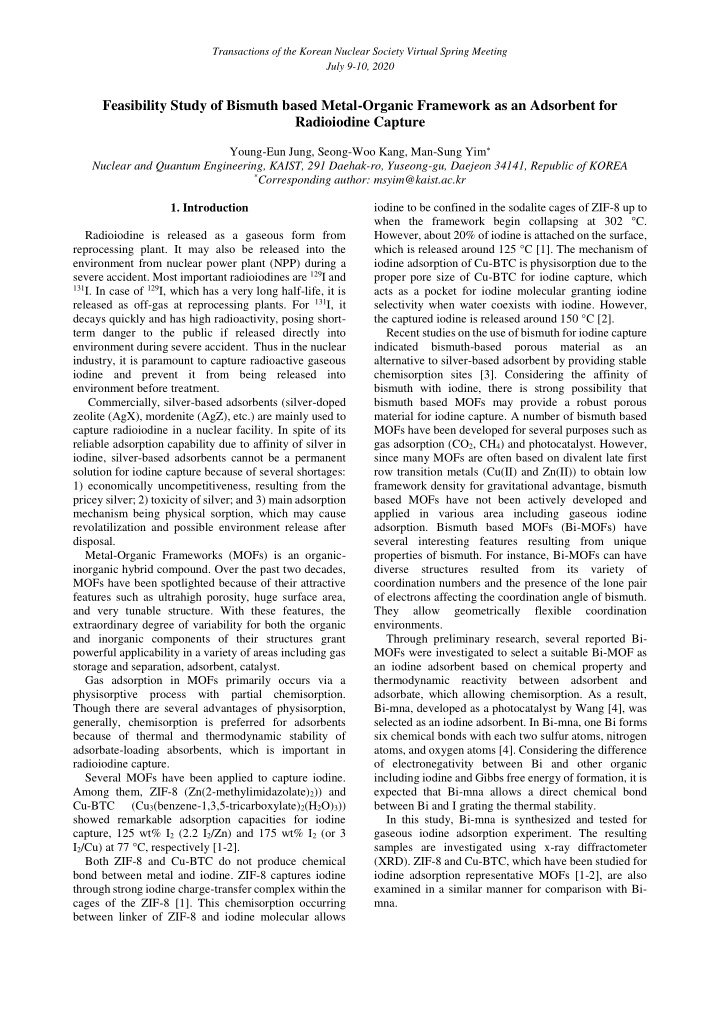



Transactions of the Korean Nuclear Society Virtual Spring Meeting July 9-10, 2020 Feasibility Study of Bismuth based Metal-Organic Framework as an Adsorbent for Radioiodine Capture Young-Eun Jung, Seong-Woo Kang, Man-Sung Yim Nuclear and Quantum Engineering, KAIST, 291 Daehak-ro, Yuseong-gu, Daejeon 34141, Republic of KOREA * Corresponding author: msyim@kaist.ac.kr 1. Introduction iodine to be confined in the sodalite cages of ZIF-8 up to when the framework begin collapsing at 302 °C. Radioiodine is released as a gaseous form from However, about 20% of iodine is attached on the surface, reprocessing plant. It may also be released into the which is released around 125 °C [1]. The mechanism of environment from nuclear power plant (NPP) during a iodine adsorption of Cu-BTC is physisorption due to the severe accident. Most important radioiodines are 129 I and proper pore size of Cu-BTC for iodine capture, which 131 I. In case of 129 I, which has a very long half-life, it is acts as a pocket for iodine molecular granting iodine released as off-gas at reprocessing plants. For 131 I, it selectivity when water coexists with iodine. However, decays quickly and has high radioactivity, posing short- the captured iodine is released around 150 °C [2]. term danger to the public if released directly into Recent studies on the use of bismuth for iodine capture environment during severe accident. Thus in the nuclear indicated bismuth-based porous material as an industry, it is paramount to capture radioactive gaseous alternative to silver-based adsorbent by providing stable iodine and prevent it from being released into chemisorption sites [3]. Considering the affinity of environment before treatment. bismuth with iodine, there is strong possibility that Commercially, silver-based adsorbents (silver-doped bismuth based MOFs may provide a robust porous zeolite (AgX), mordenite (AgZ), etc.) are mainly used to material for iodine capture. A number of bismuth based capture radioiodine in a nuclear facility. In spite of its MOFs have been developed for several purposes such as reliable adsorption capability due to affinity of silver in gas adsorption (CO 2 , CH 4 ) and photocatalyst. However, iodine, silver-based adsorbents cannot be a permanent since many MOFs are often based on divalent late first solution for iodine capture because of several shortages: row transition metals (Cu(II) and Zn(II)) to obtain low 1) economically uncompetitiveness, resulting from the framework density for gravitational advantage, bismuth pricey silver; 2) toxicity of silver; and 3) main adsorption based MOFs have not been actively developed and mechanism being physical sorption, which may cause applied in various area including gaseous iodine revolatilization and possible environment release after adsorption. Bismuth based MOFs (Bi-MOFs) have disposal. several interesting features resulting from unique Metal-Organic Frameworks (MOFs) is an organic- properties of bismuth. For instance, Bi-MOFs can have inorganic hybrid compound. Over the past two decades, diverse structures resulted from its variety of MOFs have been spotlighted because of their attractive coordination numbers and the presence of the lone pair features such as ultrahigh porosity, huge surface area, of electrons affecting the coordination angle of bismuth. and very tunable structure. With these features, the They allow geometrically flexible coordination extraordinary degree of variability for both the organic environments. and inorganic components of their structures grant Through preliminary research, several reported Bi- powerful applicability in a variety of areas including gas MOFs were investigated to select a suitable Bi-MOF as storage and separation, adsorbent, catalyst. an iodine adsorbent based on chemical property and Gas adsorption in MOFs primarily occurs via a thermodynamic reactivity between adsorbent and physisorptive process with partial chemisorption. adsorbate, which allowing chemisorption. As a result, Though there are several advantages of physisorption, Bi-mna, developed as a photocatalyst by Wang [4], was generally, chemisorption is preferred for adsorbents selected as an iodine adsorbent. In Bi-mna, one Bi forms because of thermal and thermodynamic stability of six chemical bonds with each two sulfur atoms, nitrogen adsorbate-loading absorbents, which is important in atoms, and oxygen atoms [4]. Considering the difference radioiodine capture. of electronegativity between Bi and other organic Several MOFs have been applied to capture iodine. including iodine and Gibbs free energy of formation, it is Among them, ZIF-8 (Zn(2-methylimidazolate) 2 )) and expected that Bi-mna allows a direct chemical bond Cu-BTC (Cu 3 (benzene-1,3,5-tricarboxylate) 2 (H 2 O) 3 )) between Bi and I grating the thermal stability. showed remarkable adsorption capacities for iodine In this study, Bi-mna is synthesized and tested for capture, 125 wt% I 2 (2.2 I 2 /Zn) and 175 wt% I 2 (or 3 gaseous iodine adsorption experiment. The resulting I 2 /Cu) at 77 °C, respectively [1-2]. samples are investigated using x-ray diffractometer Both ZIF-8 and Cu-BTC do not produce chemical (XRD). ZIF-8 and Cu-BTC, which have been studied for bond between metal and iodine. ZIF-8 captures iodine iodine adsorption representative MOFs [1-2], are also through strong iodine charge-transfer complex within the examined in a similar manner for comparison with Bi- cages of the ZIF-8 [1]. This chemisorption occurring mna. between linker of ZIF-8 and iodine molecular allows
Recommend
More recommend